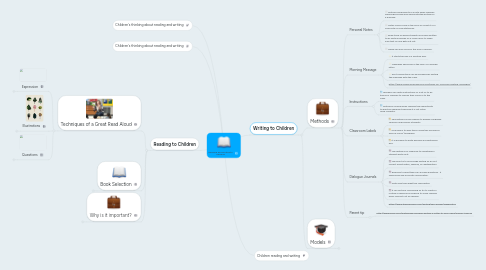
1. Reading to Children
1.1. Techniques of a Great Read Aloud
1.1.1. Expression
1.1.1.1. Practice the reading
1.1.1.2. Read at an appropriate rate.
1.1.1.3. Read all of the words correctly
1.1.1.4. Use an audible voice
1.1.1.5. Read expressively
1.1.1.6. Use different voices for different characters
1.1.1.7. Chunk the text into meaningful phrases
1.1.1.8. Maintain eye contact
1.1.2. Illustrations
1.1.2.1. Illustrations and text are interdependent.
1.1.2.2. The reader needs to consider how to show illustrations.
1.1.2.3. If illustrations are too supportive of the text, children will rely on them too heavily and not consider the text.
1.1.2.4. Teachers have the ability to project illustrations on a projector screen so they can be displayed as the teacher is reading the text.
1.1.3. Questions
1.1.3.1. Asking questions during a read aloud leads to better comprehension.
1.1.3.2. There are two types of questions.
1.1.3.2.1. Efferent questions ask about the information and the details.
1.1.3.2.2. Aesthetic questions ask the listener to make connections and inferences.
1.1.3.3. Questions can be asked before, during, or after reading.
1.1.3.4. It is important that the questions do not interfere too much with the reading of the book.
1.2. Book Selection
1.2.1. Choose books that you know and like.
1.2.2. Choose books from a variety of genres such as narrative, informational, or poetry.
1.2.3. Begin reading aloud to children on the first day of school.
1.2.4. If the children get bored, put the book down and give them the opportunity to read it on their own during an independent reading time.
1.2.5. It is not necessary to read all of the parts of the book, especially if there are controversial, offensive, or overly mature parts.
1.3. Why is it important?
1.3.1. It increases children's motivation to read by creating connections between the child and
1.3.1.1. the author
1.3.1.2. the characters
1.3.1.3. other readers of that book
1.3.1.4. the adult reader
1.3.2. It builds children's vocabularies.
1.3.2.1. Children are exposed to more unfamiliar and interesting vocabulary than they would through interactions with family or by watching television.
1.3.3. It teaches language and print concepts.
1.3.3.1. Children are exposed to more difficult texts and through that the rhythm of language.
1.3.3.2. The more difficult texts challenge children's minds, stretch their abilities, and their imagination.
1.3.3.3. Children develop their sense of directionality, that print moves from left to right and from top to bottom.
1.3.3.4. Children learn capitalization and punctuation.
1.3.4. It increases children's attention spans.
1.3.4.1. When children listen to read alouds, it increases their reading stamina.
1.3.4.2. Many children spend much of their time playing video games and watching television. They need experience getting information from different sources.
1.3.5. Also...
2. Children's thinking about reading and writing
3. Children's thinking about reading and writing
4. Writing to Children
4.1. Methods
4.1.1. Personal Notes
4.1.1.1. Writing compliments in a note gives children meaningful praise and demonstrates writing for a purpose.
4.1.1.2. Notes could come in the form of a post it or a long note on long stationary.
4.1.1.3. Keep track of which students you have written to by writing checks on a class rubric to make sure that no one gets left out.
4.1.1.4. These can also come in the form of emails.
4.1.2. Morning Message
4.1.2.1. It starts the day in a positive way.
4.1.2.2. Messages should be in the form of a friendly letter.
4.1.2.3. Print conventions can be modeled by writing the message with the class.
4.1.2.4. https://www.responsiveclassroom.org/ideas-for-morning-meeting-messages/
4.1.3. Instructions
4.1.3.1. Teachers can write instructions or a list of to do items for children to read as they come in to the class.
4.1.3.2. Writing in cursive gives children the opportunity to practice reading it because it is not often used currently.
4.1.4. Classroom Labels
4.1.4.1. This method is very helpful to English Language Learners and primary students.
4.1.4.2. One idea is to label items using two synonyms such as clock/ timepiece.
4.1.4.3. It is possible to write phrases and sentences also.
4.1.5. Dialogue Journals
4.1.5.1. The writing is in response to something a student wrote first.
4.1.5.2. The point is to encourage writing so do not correct punctuation, spelling, or capitalization.
4.1.5.3. Respond to what they say and ask questions. It should feel like a private conversation.
4.1.5.4. Write less than what the child writes.
4.1.5.5. It can be time consuming so try to create a routine in which you respond to some children every day but not all children.
4.1.5.6. https://www.teachervision.com/writing/skill-builder/48885.html
4.1.6. Parent tip
4.1.6.1. http://www.imom.com/relationship-building-writing-a-letter-to-your-child/#.WE3v17IrKM8
4.2. Models
4.2.1. Author Visits
4.2.1.1. When authors visit the classroom, children learn how authors come up with their ideas as well as their draft and revision process.
4.2.1.2. Children have the change to see work at different stages of the writing process.
4.2.1.3. Children may ask many questions.
4.2.1.4. It makes the writing process more real to children and makes them realize that they can become authors.
4.2.1.5. http://teacher.scholastic.com/products/tradebooks/inviteanauthor.htm
4.2.2. Teacher Modeling
4.2.2.1. A teacher might share
4.2.2.1.1. a story written in elementary school
4.2.2.1.2. a page from a journal
4.2.2.1.3. the rough and final draft of a college paper
4.2.2.1.4. a shopping list
4.2.2.1.5. a persuasive letter written to the class
4.2.2.2. Ask the children for feedback about the writing.
4.2.3. Author's Craft
4.2.3.1. Children and teachers may investigate books a little closer to think about how the author used language to touch our emotions or create images.
4.2.3.2. They can work together to notice powerful phrases and learn how to replicate them.

